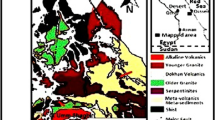Abstract
A ceramic tile batch from Egyptian raw materials includes kaolin, quartz and feldspar in addition to few additive of bentonite is designed. The phase and chemical composition of the raw materials are investigated using XRD and XRF, respectively. Kaolin is composed of kaolinite and quartz, while kaolinitic sand is formed essentially of quartz with a lesser content of kaolin. Feldspars are represented by albite and orthoclase with subordinate amounts of quartz. The batch was ground, mixed, shaped, pressed and fired from 1160 to 1260 °C. Linear shrinkage and bulk density were determined at dry state and after firing, while water absorption and porosity were detected after firing. The phase composition and microstructure as well as microchemistry of the batch fired at 1260 °C were detected using XRD and EDAX, respectively. Whiteness of the fired batches at 1260 °C is relatively low (49.85%), which is due the impurity contents in the used raw materials. It is concluded that by increasing the firing temperature, the bulk density and linear shrinkage increased, while apparent porosity and water adsorption decreased. The essential minerals of the fired batches at 1260 °C are quartz and mullite with few amounts of albite. The Microstructure and EDAX ensure the presence of primary mullite in a glass matrix.
Similar content being viewed by others
References
Kingery WD (1960) Introduction to ceramics, John Wiley and Sons, Inc., New York, P.N. 781
Mostafa A (1989) Ceramic floor tiles from Egyptian raw materials, M.Sc. Thesis, Faculty of Science, Zagazig University
Joshi CK, Malkan VG, Bhatt JV (1993) Ceramic raw materials of India. Seminar on ceramic industry raw materials & essential inputs, Ahmedabad, pp 3–44
Youssef NF, Shater MO, Abadir MF, Ibrahim OA (2002) Utilization of red mud in the manufacture of ceramic tiles. Key Eng Mater 206-213:1775–1778
Dinsdale A (1986) Pottery Science Materials, Process, and Products. Ellis Horwood Ltd.,West Sussex, U. K, ISBN 10: 0470202769 ISBN 13: 9780470202760
Kobayashi YO, Ohira YO, Kato E (1992) Vitrification of Whiteware bodies in alumina-feldspar-kaolin system. J Jpn Ceram Soc 100(5):743–749
Dondi M, Guarini G, Venturi I (2001) Assessing the fusibility of feldspathic fluxes for ceramic tiles by hot stage microscope. Ind Ceram 21:67–73
El-Fadaly E (2013) Characterization of Porcelain Stoneware Tiles Based on Solid Ceramic Wastes, International Journal of Science and Research (IJSR) ISSN, 2319–7064, P. 602–608. ISSN (Online): 2319–7064
Yaseen I, William EL (1999) Fired porcelain microstructure revisited. J Am Ceram Soc 82(12):3584–3590
Yaseen I, William EL (2000) Microstructural evolution in Triaxial porcelain. J Am Ceram Soc 83(12):3121–3127
Abadir MF, Sallam EH, Bakr IM (2002) Preparation of porcelain tiles from Egyptian raw materials. Ceram Int 28:303–310
Hirata Y, Yoshitomi A, Sameshima S (2003) Reaction, microstructures and mechanical properties of model ceramic ware in K2O-Al2O3-SiO2 system. J Ceram Soc Jpn 1296(III):560–566
Swapan KDK (2003) Differences in densification behavior of K- and Na-feldspar containing porcelain bodies. Thermochim Acta 406(1–2):199–206
Zanelli C, Soldati R, Conte S, Guarini G, Ismail AIM, El-Maghraby MS, Cazzaniga A, Dondi M (2018) Technological behavior of porcelain stoneware bodies with Egyptian syenites. Int J Appl CeramTechnol:1–12. https://doi.org/10.1007/s12633-019-00217-2
Elmaghraby MS, Ismail AIM, Sadek GD, Abd EZA (2019) Effect of Nepheline Syenite Additives on the Technological Behavior of Ceramics and Porcelain Stoneware Tiles 12
Pavlov VF, Mitrokhin VS (1979) Formation of mullite in clay firing and its connection with the properties of products. Trudy institute anilstroikeramika 32:53–75
McVay TN (1936) Physical–Chemical Reactions in Firing Whiteware. J Am Ceram Soc 19:195–197
Schuller KH (1964) Reactions between Mullite and glassy phase in porcelains. Trans Br Ceram Soc 63(2):103–117
McConville CJ, William EL, Sharp JH (1998) Microstructural evolution in fired kaolinite. Br Ceram Trans 97(4):162–168
Salam EMM, Messer PF, Ford WF (1976) Equilibrium constitution as an index of the Vitrification of Triaxial Whitewares. Trans J Br Ceram Soc 75:120–123
Cambier F and Leriche A (1996) Vitrification. In: Cahn RW, Hanson P, Kramer EJ, (eds) Processing of ceramics part II, 17B, Basel, VCH, 124–44
Zanelli C, Raimondo M, Guarini G, Dondi M (2011) The vitreous phase of porcelain stoneware: composition, evolution during sintering and physical properties. J Non-Cryst Solids 357:3251–3260
Author information
Authors and Affiliations
Corresponding author
Additional information
Publisher’s Note
Springer Nature remains neutral with regard to jurisdictional claims in published maps and institutional affiliations.
Rights and permissions
About this article
Cite this article
El-Maghraby, M.S., Ismail, A.I.M. & Shalaby, B.N.A. Utilization of some Egyptian Raw Materials in Ceramic Tiles. Silicon 13, 985–992 (2021). https://doi.org/10.1007/s12633-020-00459-5
Received:
Accepted:
Published:
Issue Date:
DOI: https://doi.org/10.1007/s12633-020-00459-5




